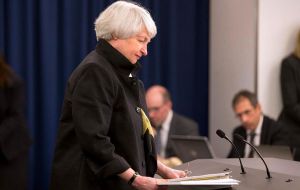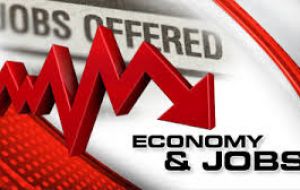MercoPress. South Atlantic News Agency
US unemployment falls to nine-year low in November, 4.6%, but earnings slowdown
 The Federal Reserve will hold its next two-day policy meeting on 13-14 December when it is expected to raise rates
The Federal Reserve will hold its next two-day policy meeting on 13-14 December when it is expected to raise rates  Janet Yellen last month indicated the Fed could raise interest rates “relatively soon”, adding that the US economy was “making very good progress”.
Janet Yellen last month indicated the Fed could raise interest rates “relatively soon”, adding that the US economy was “making very good progress”.  The economy has been creating jobs at an average of 180,000 jobs a month this year, although that is down on the average of 229,000 recorded in 2015.
The economy has been creating jobs at an average of 180,000 jobs a month this year, although that is down on the average of 229,000 recorded in 2015. United States unemployment rate fell to a nine-year low in November, adding to expectations that US interest rates will rise later this month. Figures from the Labor Department showed the US economy created 178,000 jobs in November, while the jobless rate fell to 4.6% from 4.9% in October.
The data adds to recent evidence of healthy growth in the economy, although wage growth was weaker than expected. Most analysts think the Federal Reserve will raise rates at its next meeting.
The Federal Reserve will hold its next two-day policy meeting on 13-14 December.
Last month, the chair of the Fed, Janet Yellen, indicated that the US central bank could raise interest rates “relatively soon”, adding that the US economy was “making very good progress”.
Recent figures indicated that the US economy grew at an annual pace of 3.2% in the third quarter of the year. The economy has been creating jobs at an average of 180,000 jobs a month this year, although that is down on the average of 229,000 recorded in 2015.
Despite November's robust jobs figures, earnings grew by less than expected. Average hourly earnings fell 0.1% from the month before, and that reduced the annual increase in wages to 2.5% from 2.8% in October.
The job creation figures for September and October were also revised, with the latest estimates indicating that 2,000 fewer jobs were added in the two months than previously thought.
Before these figures the markets were pretty clear about what they think the Federal Reserve will do when it meets later this month; it will raise interest rates. The jobs numbers have further reinforced that expectation.
It was a pretty robust figure for job creation, well ahead of economists' estimates of what is needed to keep up with a growing population.
Also striking was a decline of 220,000 in the number who are working part-time for economic reasons. This is another measure of what economists call “slack in the labor market” that the Fed has been watching, because it thinks the unemployment rate doesn't tell the whole story about job problems. A decline in the number of part-timers suggests some more of the “slack” being taken up.
The marked decline in the unemployment rate is a little misleading. It partly reflects people who are no longer looking for work - they are counted as “not in the labor force” rather than unemployed. That said, this is a rather strong report.
In effect the so called U-6, which refers to the total unemployed, plus all persons marginally attached to the labor force, plus total employed part time for economic reasons, as a percent of the civilian labor force plus all persons marginally attached to the labor force, stands at 9.3%.




Top Comments
Disclaimer & comment rules-

-

Read all commentsBut these figures will not show the numbers of workers who could not find another job after the crash of 2008 brought about by the lying American banks conning the world with their mortgage scams.
Dec 04th, 2016 - 10:50 am +1These workers and the ones in Britain and Europe fell off the unemployment roll and will probably never be seen again except for the black economy.
At least Clinton failed and her 'backers', many of the same financial organisations who 'weathered' the crisis by being funded by The Fed, will not be able to tell Trump what to do like they would have with her.
It's getting close to decision time for Obumma as to whether he will give her a 'keep out of jail' card aka a presidential pardon for all her misdeeds!
The 'backers' [donors/investors] don't [needn't] have any loyalty / ethics. They can “back” anyone - including Trump - who is in the position to help them grab more money! Trump MUST love this situation!
Dec 08th, 2016 - 09:37 am -1Commenting for this story is now closed.
If you have a Facebook account, become a fan and comment on our Facebook Page!